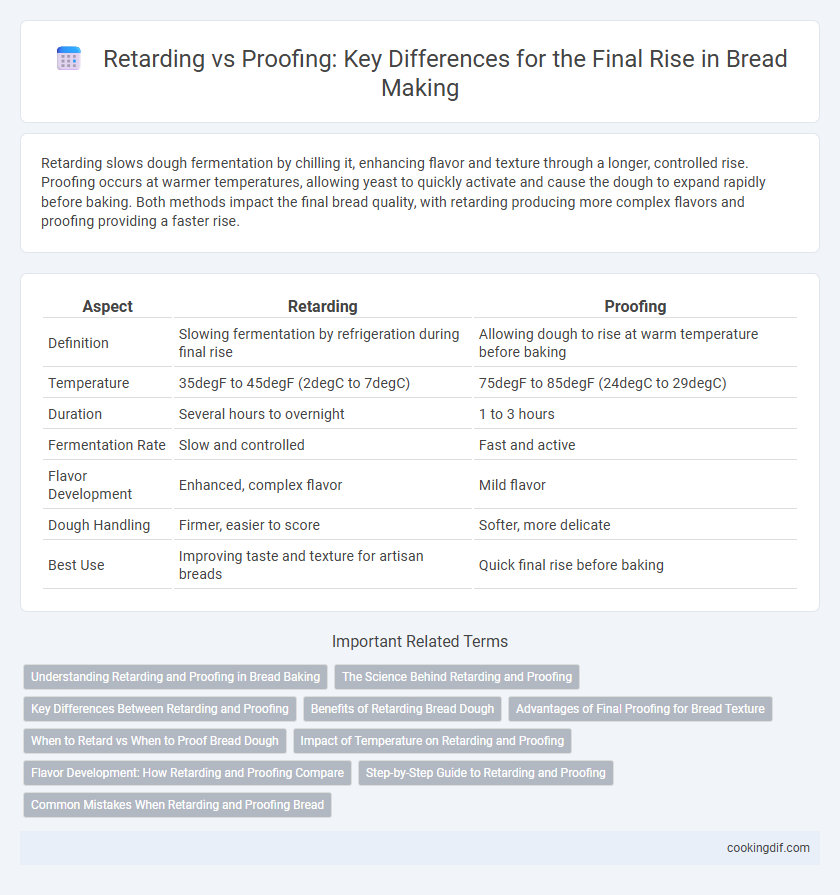Retarding slows dough fermentation by chilling it, enhancing flavor and texture through a longer, controlled rise. Proofing occurs at warmer temperatures, allowing yeast to quickly activate and cause the dough to expand rapidly before baking. Both methods impact the final bread quality, with retarding producing more complex flavors and proofing providing a faster rise.
Table of Comparison
| Aspect | Retarding | Proofing |
|---|---|---|
| Definition | Slowing fermentation by refrigeration during final rise | Allowing dough to rise at warm temperature before baking |
| Temperature | 35degF to 45degF (2degC to 7degC) | 75degF to 85degF (24degC to 29degC) |
| Duration | Several hours to overnight | 1 to 3 hours |
| Fermentation Rate | Slow and controlled | Fast and active |
| Flavor Development | Enhanced, complex flavor | Mild flavor |
| Dough Handling | Firmer, easier to score | Softer, more delicate |
| Best Use | Improving taste and texture for artisan breads | Quick final rise before baking |
Understanding Retarding and Proofing in Bread Baking
Retarding in bread baking involves slowing down yeast fermentation by refrigerating the dough, enhancing flavor complexity and improving texture during the final rise. Proofing, on the other hand, is the process of allowing dough to rest at a warm temperature to activate yeast and achieve volume increase before baking. Understanding the precise control of temperature and timing in retarding versus proofing is crucial for optimizing crumb structure and crust development in artisanal bread.
The Science Behind Retarding and Proofing
Retarding slows yeast activity by refrigerating dough, allowing enzymes to break down starches and enhance flavor complexity, while proofing accelerates yeast fermentation at warmer temperatures to increase dough volume. During retarding, the cold environment extends fermentation time, promoting organic acid development that improves texture and shelf life. Proofing activates yeast rapidly, producing carbon dioxide that causes dough expansion essential for the final rise before baking.
Key Differences Between Retarding and Proofing
Retarding slows yeast activity by refrigerating the dough, which enhances flavor development and allows for flexible baking schedules, while proofing involves keeping the dough at warm temperatures to speed up yeast fermentation and achieve the final rise. Retarding typically occurs after the first rise and before shaping or baking, whereas proofing happens after shaping and just before baking to ensure optimal volume and texture. The key difference lies in temperature control and timing, with retarding emphasizing a slow, cold fermentation and proofing focusing on a fast, warm rise.
Benefits of Retarding Bread Dough
Retarding bread dough in refrigeration slows fermentation, enhancing flavor complexity and improving dough texture by allowing enzymes more time to develop gluten and sweetness. This controlled slow rise helps produce a chewier crumb and a thicker, crisper crust, which are highly prized in artisan breads. Retarding also offers flexibility in baking schedules, allowing dough to be prepared in advance and baked fresh, ensuring optimal freshness and quality.
Advantages of Final Proofing for Bread Texture
Final proofing enhances bread texture by allowing yeast activity to fully develop gluten and gas retention, resulting in a lighter and more open crumb structure. This controlled fermentation improves crust formation and flavor complexity, optimizing the bread's overall quality. Retarding slows fermentation but does not achieve the same level of gluten relaxation and gas expansion during the final rise as proofing does.
When to Retard vs When to Proof Bread Dough
Retarding bread dough involves refrigerating it during the fermentation process to slow yeast activity, ideal for enhancing flavor complexity and controlling timing, usually done after the primary rise but before the final shaping. Proofing, on the other hand, refers to the final rise of shaped dough at room temperature, crucial for developing structure and volume before baking. Retard dough when aiming for deeper taste and flexible baking schedules, while proof at warm conditions for quicker, efficient rises and optimal crumb texture.
Impact of Temperature on Retarding and Proofing
Retarding involves slowing yeast activity by refrigerating the dough at around 4degC, which enhances flavor development by extending fermentation time without overproofing. Proofing occurs at warmer temperatures between 24degC to 30degC, accelerating yeast activity to achieve the final rise quickly but risking reduced flavor complexity. Temperature control during retarding and proofing directly impacts dough texture, gas retention, and overall bread quality, making precise thermal management essential for optimal baking outcomes.
Flavor Development: How Retarding and Proofing Compare
Retarding enhances flavor development by slowing yeast activity during the final rise, allowing enzymes more time to break down starches and create complex acids and sugars. Proofing occurs at warmer temperatures, accelerating yeast fermentation but producing a milder, less nuanced flavor profile. Longer fermentation in retarding leads to richer, tangier bread compared to the quicker proofed dough.
Step-by-Step Guide to Retarding and Proofing
Retarding delays yeast fermentation by refrigerating the dough at 38degF (3degC) for 12 to 24 hours, enhancing flavor and texture while developing complex sugars. Proofing occurs at 75-85degF (24-29degC) for 1 to 3 hours, allowing the yeast to produce carbon dioxide, causing the dough to rise and become airy. Step-by-step, retarding involves shaping the dough, sealing it airtight, refrigerating during the bulk fermentation or final rise, then proofing at room temperature before baking, whereas proofing requires maintaining consistent warmth and humidity to activate yeast fully.
Common Mistakes When Retarding and Proofing Bread
Common mistakes when retarding bread include over-chilling the dough, which slows yeast activity excessively and results in dense loaves, and failing to cover the dough properly, leading to surface drying and crust formation. In proofing, under-proofing causes tight crumb structures and limited oven spring, while over-proofing weakens gluten networks, causing collapse during baking. Maintaining precise temperature control and monitoring dough expansion are crucial to achieving optimal rise and texture.
Retarding vs Proofing for final rise Infographic

 cookingdif.com
cookingdif.com